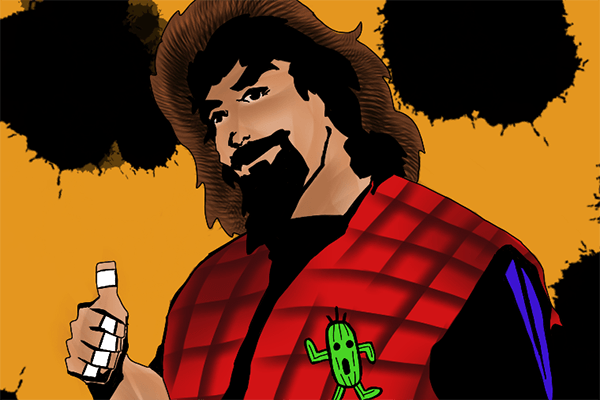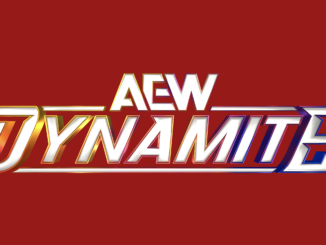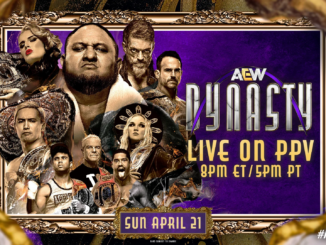
SPOTLIGHTED PODCAST ALERT (YOUR ARTICLE BEGINS A FEW INCHES DOWN)...
Top 50 Wrestlers Of The 1990s: #10-6
Here we are, after weeks upon weeks of waiting (it may feel like the 2090s at this point now), and weeks upon weeks of list after list, we’ve finally broken into the top 10. However, before you all scratch your neck beards with disdain at #10-6 let’s recap the first 40:
#50. Ken Shamrock
#49. Dean Malenko
#48. Jeff Jarrett
#47. Big Bossman
#46. The Sandman
#45. Davey Boy Smith
#44. The Giant
#43. Taz
#42. Ron Simmons
#41. Rob Van Dam
#40. Eddie Guerrero
#39. Chris Benoit
#38. Sabu
#37. Rey Mysterio, Jr.
#36. Sid Vicious
#35. Kane
#34. Sean Waltman
#33. Chris Jericho
#32. Goldust
#31. Raven
#30. The New Age Outlaws
#29. Brian Pillman
#28. The Steiner Brothers
#27. Bam Bam Bigelow
#26. Lex Luger
#25. Terry Funk
#24. Ted DiBiase
#23. Rick Rude
#22. Jake “The Snake” Roberts
#21. Big Van Vader
#20: Roddy Piper
#19: Triple H
#18: Diamond Dallas Page
#17: Yokozuna
#16: Owen Hart
#15: Mr. Perfect
#14: Ultimate Warrior
#13: Macho Man Randy Savage
#12: Sting
#11: Goldberg
Alright, so now the Top Ten. I wrote this out, walked away for a day, sat back down to rearrange a few, and still wasn’t sure if it was accurate, but I’m confident enough to let it fly it’s way into the ether of the world wide web.
#10: Kevin Nash
Hailing From: Detroit, Mich.
Finisher: Jacknife Powerbomb
The Giant Killer. Big Sexy. Big Daddy Cool. Super Shredder. All those monikers belonged to Kevin Nash, but so did Master Blaster Steel, Oz and Vinny Vegas before he big-rigged his seven foot frame over to the WWF as Diesel in 1993.
He started out as Shawn Michaels bodyguard, but Vince McMahon loves the monsters and Nash was far from Giant Gonzalez in the looks department. There was no denying Nash’s suave, casual-cool demeanor which made him a unique persona in the land of giants. It didn’t take long for him to get the Intercontinental strap and eventually the WWF Championship which he held for almost a year (again, a real long time to be holding any wrestling title at the time – my 10-year-old brain exploded when considering that amount of longevity.)
People criticize Diesel’s reign as champ at being a low point for the WWF, but from that perspective, it’s really a transitional time. Very rarely do you see one hot act jump immediately into another and Nash was credible enough to add to that list of banner bearers as they made a transition into a new “generation.” While Nash’s run with the WWF Championship isn’t one of the most memorable, he did help that transition. It’s not like Shawn Michaels didn’t take the same licks with his initial run as champ. Everyone was suffering from the need of change. A dry, too kid-friendly and kid-oriented product.
And Nash’s cool-edgy persona really was on showcase for WCW as the co-founder of the N.W.O. Him and Scott Hall lived up to their name as The Outsiders considering the Wolfpac stood out from the rest.
His run as WCW Heavyweight Champion can absolutely be categorized under the “not booked properly” catalogue (depending on who you ask, that may or may not have been by Nash’s own hand) considering it damaged the very hot act that was Goldberg. However, think about how things would have been if a post-Diesel Nash would have been if in the hands of late 90s era WWF. That casual-cool prick would have been a great adversary to a Steve Austin, a Rock or even a DX.
Nash didn’t quite reach that level of stardom, but enough to get him in the top 10 of the decade? You betcha.
#9: Ric Flair
Hailing From: Charlotte, N.C.
Finisher: The Figure-Four Leg Lock
Many may be surprised that the dirtiest player in the game comes in at #9, but out of his 30+ years of wrestling Flair’s 1990s run was probably his less impactful. However, that’s like saying Tom Brady had a bad season last year because he didn’t win the Super Bowl.
You look at what Ric did in the beginning of the decade and it’s nothing short of historic. Taking the NWA Heavyweight Title to the WWF? Having arguably the (literal) greatest Royal Rumble performance in 1992? Those moments defined the Nature Boy for some of us 30-somethings when we think of Ric Flair who didn’t get the benefit of growing up with all the spilt liquor and Rolexes of his time in Crockett Promotions.
Flair returned to the hometown team with WCW in 1994 and had another five runs with the belt, but WCW was struggling to keep it’s relevancy with its inability and lack of desire to create new stars. Aside from Vader and Dustin Rhodes for a time, WCW tended to lean too hard on the older acts and half-assed, big budget mini movies rather see the main event potential of a Steve Austin or a Cactus Jack (screw that, the people want to see RoboCop rescue Sting!)
And sure, Flair could be categorized as one of those “older acts”, but this is Ric Flair we’re talking about here, not Bugsy McGraw. The LeBron James of professional wrestling when you consider his longevity of great in-ring performances. Imagine the matches or feuds Flair could have had in the 90s if he continued wrestled the likes of Bret Hart, Shawn Michaels, Stone Cold, The Rock and Mick Foley instead of say, same-age acts as a Hulk Hogan, a Roddy Piper or Randy Savage. All older acts benefit from working with younger talent and 2000s era Ric Flair is proof of that considering the career renaissance he had during that decade.
However, the 1990s Ric Flair is nothing to strut away from despite being booked badly later in the decade. The impact he made in the earlier half helped to transition the hot era of 80s wrestling into the 1990s and in doing so, the Nature Boy set the table for the new stars to come.
#8: Mick Foley
Hailing From: Truth Or Consequences, New York
Finisher: The Mandible Claw, Double-Arm DDT
When you have three distinct personas in one decade how can you not make the top ten? Like several on this list, Mick Foley was a journeyman through and through in 1990s wrestling, but unlike those other journeymen, Foley left a strong influence anywhere he went.
Cactus Jack was unlike anybody else featured on WCW’s early 1990s card and time and time again would steal the show with his look, his persona and his risk-taking. He did the same during his time overseas and eventually in ECW.
He championed the ECW brand with that risk-taking, but also had those same fans raging with hate as he acted like the safe, corporate-schill ass kisser to his former boss, Eric Bischoff. Mick was masterful on the mic and some of those ECW promos exemplified that one-of-a-kind talent.
Putting that man behind a mask in WWF gave Mick a different vibe, but it was not anything he couldn’t make work. From dark, emotionally damaged, hair-pulling creep to misunderstood misfit underdog, Mick fully embraced the role of Mankind and with the right amount of testicular fortitude, he turned it into his very own that gave him a spot in the main event picture and three runs as WWF Champion in the decade.
Always modest, Foley never gets nearly enough credit from WWE as being one of their top stars of the 1990s. If it wasn’t for Mick, several stars’ legacies wouldn’t be as big as they are today and the tide wouldn’t have changed for WWF in the ratings war. Mankind, Cactus Jack, Dude Love and Mick Foley all proved that he could “put butts in the seats.”
#7: Scott Hall
Hailing From: Miami, Fla.
Finisher: The Razor’s Edge
You wanted cool in mid-1990s WWF? Nothing, nothing got more cooler than Scott Hall, who out of this whole list of 50, had one of the most notoriously underrated runs on this list.
With the looks inspired with the help of DDP and the movie Scarface, Scott Hall stood out above a lot of your normal “boots and trunks” lot with jet black hair, toothpicks and colors straight out of a Michael Mann series . He would start off as a true “bad guy” by insulting waiters and kicking sand at beach bums, but after losing in upset fashion to the 1-2-3 Kid on an episode of Raw and gaining some humility, Razor flipped the switch from bad to good as smooth as one of his fallaway slams. He became one of the top faces in the company without ever having to get the WWF Championship gold around his waist.
Instead, Razor held Intercontinental gold an unprecedented (at the time) four times in the decade and in doing so kept the title at a high-rate of notoriety (having one of the most classic matches in WWF history with Shawn Michaels also helps that cause.) Not only that, but like the Pipers, Perfects, and Hitman Harts before him, Razor was undoubtedly the act that older fans of the WWF product could latch onto and wave that wrestling fandom flag proudly. Razor wasn’t a wrestler you were afraid to show to your friends because he didn’t look like the face-painted, bleach-blonde stereotypes of the late 80’s early 90’s. He started the edginess of WWF by being “The Bad Guy” that people liked before there was Stone Cold
That’s even before changing the wrestling landscape with his Nitro debut on May 27, 1996. Coming out of the crowd in denim, resembling the Razor character, but not 100% saying who he was – that was what the wrestling business needed at the time and Hall delivered. He was the perfect persona to step through that crowd on that fateful Monday Night and light WCW on fire until it was charred to black and white by the N.W.O. Even if it’s heard at nauseam at this juncture, the New World Order (maybe only to the Four Horsemen) became one of wrestling’s all-time greatest factions because it created so many unknowns for the time period. The N.W.O. brought the “outlaw” back to mainstream wrestling in a time where you had trashmen, clowns and making one lose sight of what made professional wrestling cool. And as I stated earlier, nobody was cooler than Scott Hall. Him bringing in the N.W.O. puts him at a solid #7.
#6: The Undertaker
Hailing From: Death Valley
Finisher: The Tombstone Piledriver
Although the 90s was his first go-around, an extremely heavy argument could be made that The Undertaker had a better decade (or even decades) to come as his legend was one to grow with age. Still, the mystery and presentation of the Deadman made him a gimmick that fans would pay to see for almost 30 years kicking and me not putting him in the top ten would be a grave mistake on my part.
Taker initially rose from the depths of Death Valley (which was also known as WCW) as “Mean” Mark Callous, but after not catching fire with them (like many top acts to follow) he made his way up north to start off in WWF.
He originally had the name of (get this) Kane The Undertaker before dropping it when he made his official debut at the 1990 Survivor Series. Beginning with Ted DiBiase, then transitioning to Brother Love and eventually cementing the early part of his legend under the watch of the ghastly Paul Bearer, Undertaker was an act perfect for WWF’s cast of larger-than-life personas and his was one with the most supernatural pizzaz. It was a year later in 1991 the Deadman defeated Hulk Hogan at Survivor Series for the WWF Championship. From that point on, Undertaker continued to establish himself as one of the most intriguing acts as he went on to battle Jake The Snake, Kamala and Yokozuna in the first half of of the decade. He’d also have stand out bouts with Diesel and Mankind and would win the WWF Championship a second time when he took on Sycho Sid at WrestleMania XIII.
Soon his brother Kane would show up to exact revenge on his older brother (probably because of the whole name thing, but probably didn’t help that his face got burned in a fire and his mother also died in said fire) as Taker tried for the WWF Championship against a degenerate Shawn Michaels. This feud would boil into WrestleMania XIV and not too long after Taker’s persona would take a trip down to Satanville as he formed the Ministry of Darkness, that was chock full of brainwashing, blood sacrifices and vampires. To say the least, it fit pretty damn well into the Attitude Era. Undertaker comes in at the lofty number of six, but even then, had room to grow.
Did I walk the Razor’s Edge of inaccuracy, chico, or was this one more for the good guys? Let me have it on Twitter @DominicDeAngelo.
NOW CHECK OUT THE PREVIOUS COLUMN: The Top 50 Wrestlers Of The 1990s (pt. 8) – #15-11: Randy Savage, Goldberg, Sting, Ultimate Warrior, Mr. Perfect




Leave a Reply
You must be logged in to post a comment.